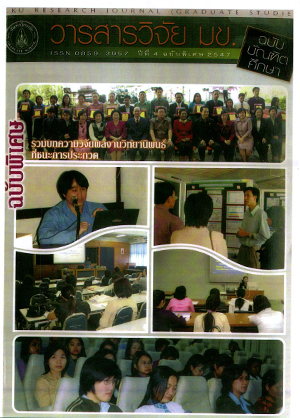การศึกษาค่าปกติจากภาพถ่ายรังสีกะโหลกศีรษะด้านข้างของเด็กหญิงและเด็กชายไทย อายุ 12-14 ปี ในจังหวัดขอนแก่นมีรูใบหน้าด้านข้างที่ยอมรับว่าสวยงาม (Lateral Cephalomwtric Norms for 12-14 year Thai Girls and Boys in Khon Kaen Who Have Acceptable Facial Profiles)
Keywords:
Lateral Cephalometric Norms Cephalometric Standards Cephalometric AnalysesAbstract
การศึกษานี้มีจุดมุ่งหมายเพื่อหาค่าปกติจากภาพถ่ายรังสีหัวกะโหลกศีรษะด้านข้างของเด็กหญิงและเด็กชายไทยอายุ 12-14 ปีในจังหวัดขอนแก่นซึ่งมีรูปใบหน้าด้านข้างที่ยอมรับว่าสวยงาม รวมทั้งศึกษาความแตกต่างของลักษณะโครงสร้างใบหน้าระหว่างเพศ กลุ่มตัวอย่างของการวิจัยเป็นเพศหญิงจำนวน 106 คน ซึ่งมีอายุเฉลี่ย 13.1 ปี และเพศชายจำนวน 67 คนซึ่งมีอายุเฉลี่ย 13.0 ปี คุณสมบัติของตัวอย่างจะต้องมีรูปใบหน้าด้านข้างที่ยอมรับว่าสวยงาม การซ้อนเกหรือช่องห่างของฟันหน้าไม่เกิน 3 มิลลิเมตร การซ้อนทับของฟันหน้าหน้าในแนวระนาบและแนวดิ่งมีขนาด 1 ถึง 4 มิลลิเมตร และไม่เคยได้รับการรักษาทางทันตกรรมจัดฟันมาก่อนผลการศึกษาแสดงในรูปค่าเฉลี่ยและค่าเบี่ยงเบนมาตรฐานของตัววัดจำนวน 53 ค่าแยกตามเพศ ซึ่งแบ่งออกเป็น4 กลุ่มย่อยคือ ตัววัดความสัมพันธ์ของกระดูกกะโหลกศีรษะด้านข้างในแนวหน้า-หลัง ตัววัดความสัมพันธ์ของกระดูกระโหลกศีรษะด้านข้างในแนวดิ่ง ตัววัดความสัมพันธ์ของฟัน ตัววัดความสัมพันธ์ของเนื้อเยื่ออ่อนรูปหน้าด้านข้าง ผลพบว่าลักษณะโครงสร้างที่แตกต่างกันอย่างมนัยสำคัญ (P<0.05) ระหว่างเพศคือ บางตัววัดของโครงสร้างกระดูกกะโหลกศีรษะและเนื้อเยื่ออ่อนรูปหน้าด้านข้าง ในส่วนโครงสร้างกระดูกที่เป็นขากรรไกรบนและขากรรไกรล่างของเด็กหญิงที่ยื่นมากกว่าเด็กชายเมื่อเทียบกับฐานกะโหลกศีรษะด้านหน้าและระนาบวัดใบหน้าส่วนกลาง ในขณะที่เด็กชายมีขนาดของส่วนฐานกะโหลกศีรษะด้านหน้า ขากรรไกรบนและขากรรไกรล่างใหญ่กว่าเด็กหญิง รวมทั้งมีความชันของส่วนฐานกะโหลกด้านหน้ามากกว่าเด็กหญิง ในส่วนของเนื้อเยื่ออ่อนรูปหน้าด้านข้างเด็กหญิงมีตำแหน่งคางยื่นไปข้างหน้า (G-Pong’) มากกว่าเด็กชาย ในขณะที่เด็กชายมีรูปหน้าด้านข้างอูมกว่าริมฝีปากบนหนากว่า ขนาดของริมฝีปากบนและล่างยาวกว่า และจุดหวำใต้ริมฝีบากล่างอยู่ลึกกว่าเด็กหญิง ผลการศึกษาในครั้งนี้แสดงให้เห็นถึงความแตกต่างของลักษณะโครงสร้างใบหน้าระหว่างเด็กหญิงและเด็กชายดังนั้นจึงควรพิจารณาใช้ค่าปกติจากภาพถ่ายรังสีกะโหลกศีรษะด้านข้างของเด็กอายุ 12-14 ปีในจังหวัดขอนแก่นแยกเฉพาะสำหรับเด็กหญิงและเด็กชาย
The purpose of study was to develop lateral cephalometric norms for 12-14 year Thai girls and boys in Khon Kaen Province who had acceptable facial profiles and to compare lateral cephalometric norms between genders. The subjects evaluated in the study include 106 girls with a mean age of 13.1 years and 67 boys with a mean age of 13.0 years who had esthetically acceptable profile, and no more than 3 mm. crowding or spacing of anterior teeth, 1 – 4 mm. overjet and over bite, and no previous orthodontic treatment. Mean and standard deviation of each of 53 lateral cephalometric measurements, which were separated into
four subgroups including skeletal sagittal and vertical relationships, dental and soft tissue relationships,
for both sexes are presented. Significant differences (P<0.05) between girls and boys were found in
some skeletal and soft tissue measurements. In skeletal pattern, the girls had more protrusive maxillae
and mandibles relative to anterior cranial base and midfacial plane than the boys, whereas the boys had
larger sizes of anterior cranial bases, maxillae, mandibles, lower anterior facial heights, and slightly
steeper anterior cranial bases than the girls. For soft tissue measurements, the girls had more chin
prominences (G-Pog') than the boys, while the boys had more facial convexities (G-Sn- Pog'),
thicker upper lips, longer upper and lower lips, and deeper mentolabial sulci, than the girls. Sexual
dimorphism was indicated for this study. It appears that separate sex cephalometric norms are required
for patients between 12 and 14 years of age in Khon Kaen.



